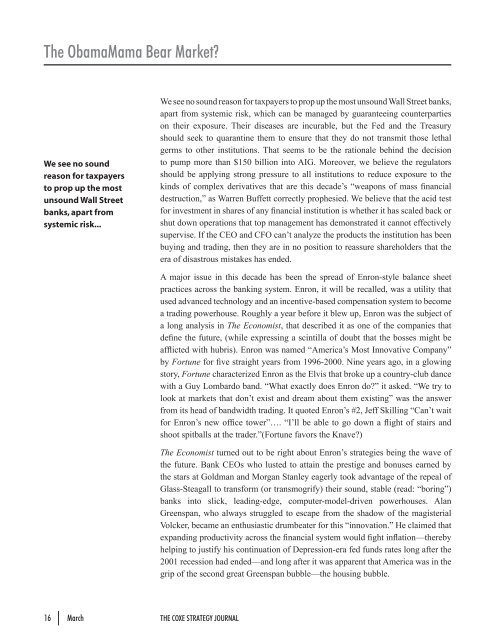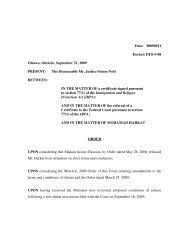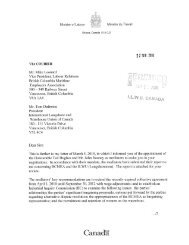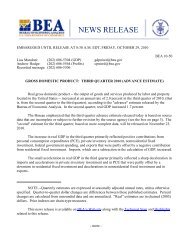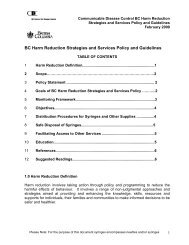Basic Points - The Globe and Mail
Basic Points - The Globe and Mail
Basic Points - The Globe and Mail
You also want an ePaper? Increase the reach of your titles
YUMPU automatically turns print PDFs into web optimized ePapers that Google loves.
<strong>The</strong> ObamaMama Bear Market?<br />
We see no sound<br />
reason for taxpayers<br />
to prop up the most<br />
unsound Wall Street<br />
banks, apart from<br />
systemic risk...<br />
We see no sound reason for taxpayers to prop up the most unsound Wall Street banks,<br />
apart from systemic risk, which can be managed by guaranteeing counterparties<br />
on their exposure. <strong>The</strong>ir diseases are incurable, but the Fed <strong>and</strong> the Treasury<br />
should seek to quarantine them to ensure that they do not transmit those lethal<br />
germs to other institutions. That seems to be the rationale behind the decision<br />
to pump more than $150 billion into AIG. Moreover, we believe the regulators<br />
should be applying strong pressure to all institutions to reduce exposure to the<br />
kinds of complex derivatives that are this decade’s “weapons of mass financial<br />
destruction,” as Warren Buffett correctly prophesied. We believe that the acid test<br />
for investment in shares of any financial institution is whether it has scaled back or<br />
shut down operations that top management has demonstrated it cannot effectively<br />
supervise. If the CEO <strong>and</strong> CFO can’t analyze the products the institution has been<br />
buying <strong>and</strong> trading, then they are in no position to reassure shareholders that the<br />
era of disastrous mistakes has ended.<br />
A major issue in this decade has been the spread of Enron-style balance sheet<br />
practices across the banking system. Enron, it will be recalled, was a utility that<br />
used advanced technology <strong>and</strong> an incentive-based compensation system to become<br />
a trading powerhouse. Roughly a year before it blew up, Enron was the subject of<br />
a long analysis in <strong>The</strong> Economist, that described it as one of the companies that<br />
define the future, (while expressing a scintilla of doubt that the bosses might be<br />
afflicted with hubris). Enron was named “America’s Most Innovative Company”<br />
by Fortune for five straight years from 1996-2000. Nine years ago, in a glowing<br />
story, Fortune characterized Enron as the Elvis that broke up a country-club dance<br />
with a Guy Lombardo b<strong>and</strong>. “What exactly does Enron do?” it asked. “We try to<br />
look at markets that don’t exist <strong>and</strong> dream about them existing” was the answer<br />
from its head of b<strong>and</strong>width trading. It quoted Enron’s #2, Jeff Skilling “Can’t wait<br />
for Enron’s new office tower”…. “I’ll be able to go down a flight of stairs <strong>and</strong><br />
shoot spitballs at the trader.”(Fortune favors the Knave?)<br />
<strong>The</strong> Economist turned out to be right about Enron’s strategies being the wave of<br />
the future. Bank CEOs who lusted to attain the prestige <strong>and</strong> bonuses earned by<br />
the stars at Goldman <strong>and</strong> Morgan Stanley eagerly took advantage of the repeal of<br />
Glass-Steagall to transform (or transmogrify) their sound, stable (read: “boring”)<br />
banks into slick, leading-edge, computer-model-driven powerhouses. Alan<br />
Greenspan, who always struggled to escape from the shadow of the magisterial<br />
Volcker, became an enthusiastic drumbeater for this “innovation.” He claimed that<br />
exp<strong>and</strong>ing productivity across the financial system would fight inflation—thereby<br />
helping to justify his continuation of Depression-era fed funds rates long after the<br />
2001 recession had ended—<strong>and</strong> long after it was apparent that America was in the<br />
grip of the second great Greenspan bubble—the housing bubble.<br />
16 March<br />
THE COXE STRATEGY JOURNAL


